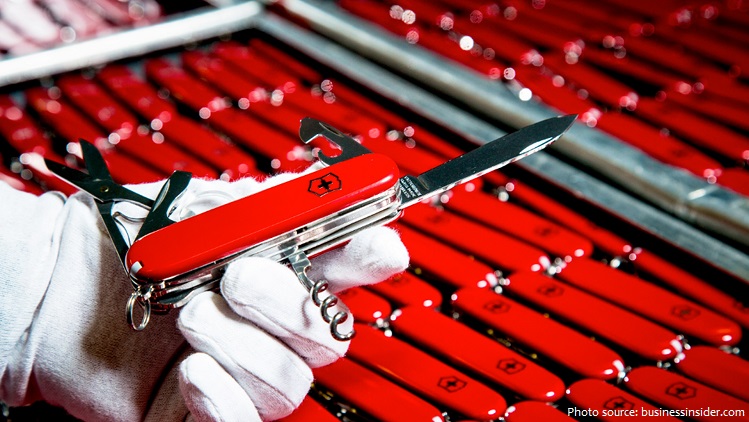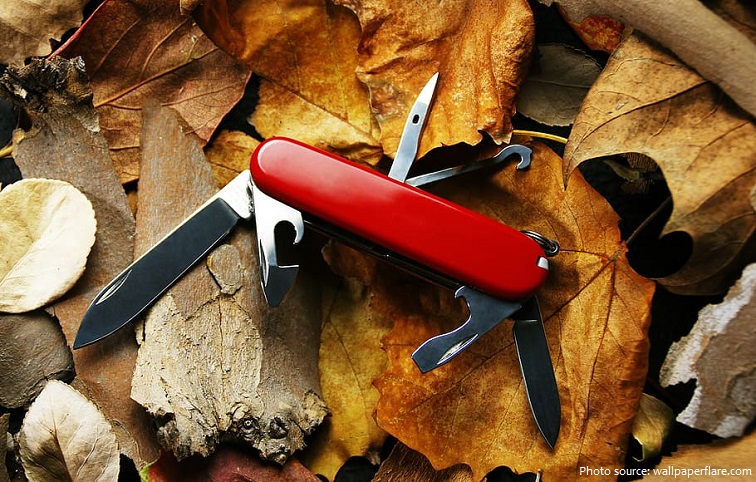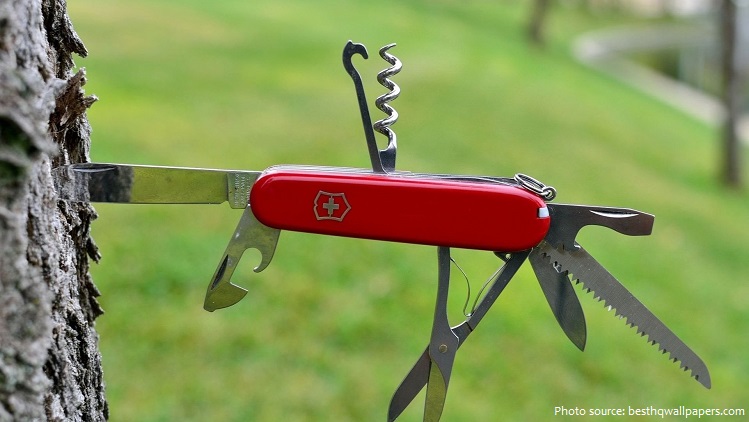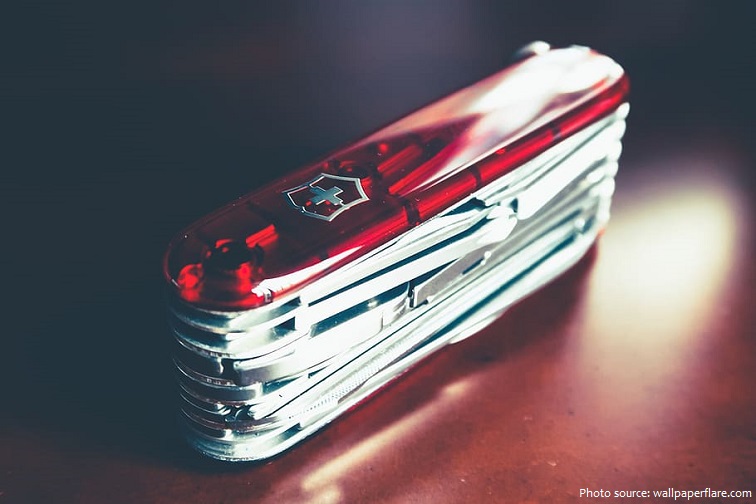
Swiss Army knife is a multibladed pocketknife manufactured by Victorinox.
A red handle, a small white cross, a blade or two, and fold-out tools for the job — a Swiss Army Knife is an icon of utility and smart design recognizable the world over.
There are various models of the Swiss Army knife with different tool combinations. Though Victorinox doesn’t provide custom knives, they have produced many variations to suit individual users.
The Swiss Army Knife was not the first multi-use pocket knife. In 1851, in Moby-Dick (chapter 107), Herman Melville mentions the “Sheffield contrivances, assuming the exterior – though a little swelled – of a common pocket knife; but containing, not only blades of various sizes, but also screw-drivers, cork-screws, tweezers, awls, pens, rulers, nail-filers and countersinkers.”

The world of Swiss Army Knives was created in 1891 by the Swiss manufacturer now known as Victorinox, with the help of many smaller Swiss cutlers. They manufactured the first Swiss Soldier Knife for the Swiss Army, and one has been issued to every enlisted person since then.
In 1908 the Swiss manufacturer now known as Wenger also started making these knives, and the supply of the Soldier knife was split in half across the two manufacturers by the Swiss military. The two companies Victorinox (‘The Original Swiss Army Knife’), and Wenger (‘The Genuine Swiss Army Knife’) are the only organisations legally allowed to use the term Swiss Army Knife in reference to their products.
In 1921, the invention of stainless steel (Inox) is a highly significant development for the cutlery industry. The combination of the two words “Inox” and “Victoria” results in today’s company and brand name – Victorinox.

Ever practical, the Swiss Army knife was primarily a tool used by soldiers, which prompted the popular name in English “Swiss Army knife,” a term coined by American soldiers who had difficulty pronouncing their German name, “Schweizer Offiziersmesser,” or “Sackmesser” in the local Swiss-German dialect. To this day, each military recruit (which includes most of the male population, since the Swiss have compulsory military service for all men when they reach the age of adulthood) receives a Swiss Army knife upon beginning their service. Ironically, Victorinox, a company founded to keep Swiss soldiers from carrying German-made knives, is now the official supplier of pocket knives to the German Army.
In 1945, US soldiers stationed in Europe after World War Two buy it in large quantities and it is a popular souvenir to take home.

In 1977, the Original Swiss Army Knife becomes an exhibit for design at the Museum of Modern Art the in New York.
During 1961–2005, the pocket knives issued to the Swiss military were produced exclusively by Victorinox and Wenger.
On 26 April 2005, Victorinox acquired Wenger, once again becoming the sole supplier of knives to the Military of Switzerland. Victorinox at first kept the Wenger brand intact, but on 30 January 2013, the company announced that the Wenger brand of knives would be abandoned in favour of Victorinox. The press release stated that Wenger’s factory in Delémont would continue to produce knives and all employees at this site will retain their jobs. They further elaborated that an assortment of items from the Wenger line-up will remain in production under the Victorinox brand name. Wenger’s US headquarters will be merged with Victorinox’s location in Monroe, Connecticut. Wenger’s watch and licensing business will continue as a separate brand: SwissGear.

Up until 2008 Victorinox AG and Wenger SA supplied about 50,000 knives to the military of Switzerland each year, and manufactured many more for export, mostly to the United States. Commercial knives can be distinguished by their cross logos – the Victorinox cross logo is surrounded by a shield while the Wenger cross logo is surrounded by a slightly rounded square.
Victorinox registered the words “Swiss Army” and “Swiss Military” as a trademark in the US and was sued at Bern cantonal commercial court by the Swiss Confederacy (represented by Armasuisse, the authority representing the actual Swiss military), in October 2018. After an initial hearing Victorinox agreed to cede the registration in the United States of the term “Swiss military” to Armasuisse in return for an exclusive licence to market perfumes under the same name.

Victorinox models are available in 58 mm (2.3 in), 74 mm (2.9 in), 84 mm (3.3 in), 91 mm (3.6 in), 93 mm (3.7 in), 100 mm (3.9 in), 108 mm (4.3 in) and 111 mm (4.4 in) lengths when closed. The thickness of the knives varies depending on the number of tool layers included. The 91 mm (3.6 in) models offer the most variety in tool configurations in the Victorinox model line with as many as 15 layers.
Wenger models are available in 65 mm (2.6 in), 75 mm (3.0 in), 85 mm (3.3 in) 93 mm (3.7 in), 100 mm (3.9 in), 120 mm (4.7 in) and 130 mm (5.1 in) lengths when closed. Thickness varies depending on the number of tool layers included. The 85 mm (3.3 in) models offer the most variety in tool configurations in the Wenger model line, with as many as 10 layers.
The most multifunctional penknife is the Swiss Army Giant Knife 2007, manufactured by Wenger S.A. in Delémont, Switzerland, in 2007, which contains 87 tools and offers 141 different functions. In addition to the traditional features found on a Swiss Army knives (e.g. blades, corkscrew, tweezers) are tools such as a laser pointer, a cigar cutter and a bike-chain rivet setter!
Most expensive multi-tool pocket knife an 18-carat gold Swiss army knife produced by Swiss jeweller Luzius Elmer has a current retail price of $4,299 (£3,026).
